| Special
Relativity ------------------------------------
|
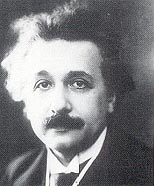 Albert Einstein (1879-1955) |
Important Terms
| Proper time Dt0:
The length of time of some event as observed by a person at rest with respect to the event. Proper length L0:
The length of an object |
Contracted length L:
The length of an object observed by a person moving with respect to the object. ---------------------------------------------------- Simple rule: If there's zero movement relative to the |
Important Equations and Concepts
| Length Contraction
L = L0 (1-v2 /c2)1/2 If the object is moving with respect to an observer in an inertial reference system, it's smaller for that observer. ------------------------------------ Time Dilation Dt = Dt0 / (1 - v2/c2)1/2 If the event is moving with respect |
Mass Transformed into Energy DE = Dmc2 Mass gained or lost is equal Energy E gained or lost is |
Total Energy E = mc2 / (1 v2/c2)1/2 ----------------------------- Rest Energy E0 = mc2 ----------------------------- Kinetic Energy KE = E E0 The kinetic energy is not 1/2 mv2. |
Einstein's Speed of Light Postulate
| If a source of light is not accelerating with
respect to an observer, the speed of light is always 300,000 km/s in a vacuum, no matter what the relative speed between source and observer may be. |
(End preview)
Inertial Systems
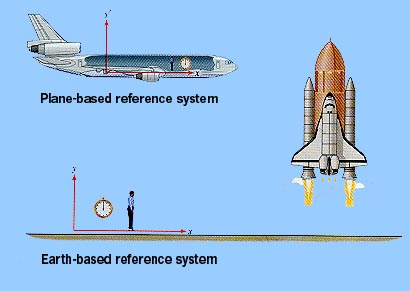 |
Law of Inertia:
If no net force is acting on an
Inertial reference system: Any place in which Newtons |
Laws of Physics Same in All Inertial Systems
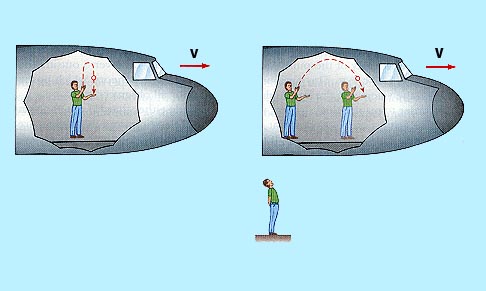 |
Both observers say that the balls motion is exactly as expected from the acceleration caused by the pull of the earth. Both observers see the |
Speed of Light in Vacuum Same in All Inertial Systems
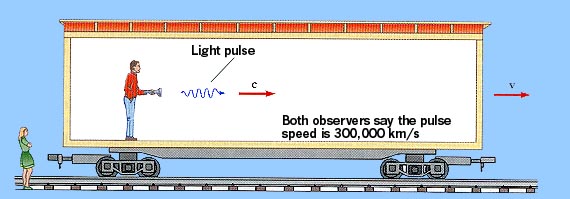 Both obervers measure the speed of light to be the same; the speed of light is seen to be the same in both inertial systems. |
Light Clock
 |
Time Dilation
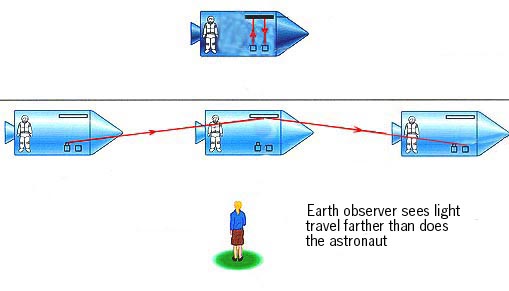 |
Astronaut and earth observer each are in an inertial system, so each measures the same value for the speed of light, 300,000 km/s. Which person reports the longer time interval between the two events (departure of light from source, arrival at the detector) ?
|
Time Dilation Explained: Part One
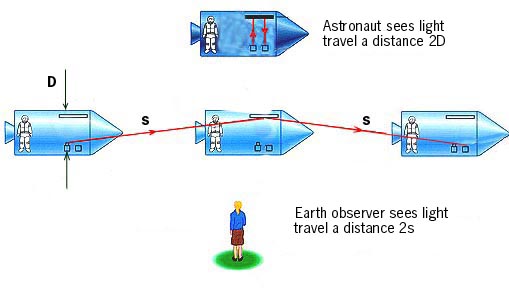 |
Each observer sees light propagate at the same speed: c = 300,000 km/s ---------------------------------- Since each observer sees the light travel a different distance, each observer measures a different time interval. Astronaut: Dt0 = 2D / c Observer: Dt = 2s / c
|
Time Dilation Explained: Part Two
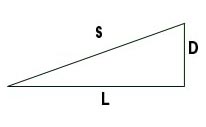 Pythagoras: s2 = L2 + D2 (1) |
Dt =
time interval observed by earth observer s = c Dt
(2) Dt0
= time interval D = cDt0 (3)
|
Distance traveled by spacecraft: L = v Dt (4) ---------------------------------- Substituting into (1): c2 (Dt)2 = v2 (Dt)2 + c2 (Dt0)2 (5) Solve this for (Dt)2:
Dt = Dt0 / (1 - v2/c2)1/2 (6) |
The Lifetime of a Muon
| Muons are unstable particles produced when protons streaming in from the sun are absorbed in the atmosphere. About one muon strikes each one cm2 of the earth's surface each second. Muons travel at a little less than the Observers at rest with respect these
|
Dt0=
2.2 ms
Dt = Dt0 / (1 - v2/c2)1/2 v / c = 0.99 [1 (.99)2]1/2 = 0.14 = 2.2 ms / 0.14 = 15.6 ms Earth observer measures the lifetime |
Time Dilation
| Question:
The star Alpha Centauri 4.3 is light years away.
If a Answer: The traveler is stationary with respect to the
events |
The earth observer says the trip takes Dt = 4.3 / 0.95 = 4.5 years ----------------------------- Dt = Dt0 / (1 - v2/c2)1/2 Rearranging: Dt0 = Dt (1 - v2/c2)1/2 = 1.4 years |
The Twin Problem: An Apparent Paradox
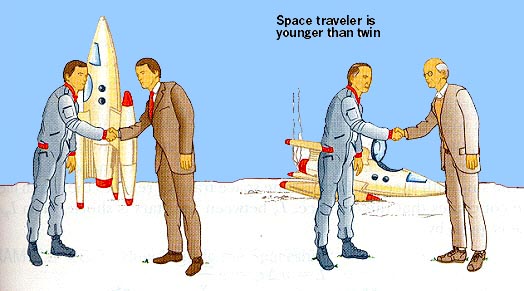 |
Person on earth remained in an inertial reference system. -------------------------------- The space- traveler accelerated, and thus wasn't in an inertial reference system. ------------------------------- The special theory of relativity is valid for the person on earth, but not for the space traveler because he was in a non-inertial reference system.(Twin paradox) |
Length Contraction
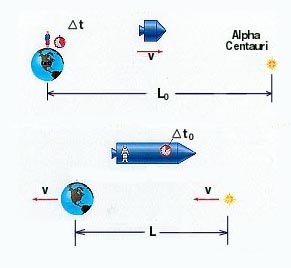 |
Earth observer measures L0: The earth observer is at rest with respect to the earth-star line, so he measures the proper length L0. Astronaut measures Dt0: Since the astronaut's clock is at the beginning and end of the event--at his departure from earth, and at his arrival at the star-- he measures the proper time Dt0. |
Each observer measures the same relative speed: v = v L0 / Dt = L / Dt0 L = L0 (Dt0 /Dt) Dt =Dt0(1- v2/c2)1/2 Substituting: L = L0 (1- v2 /c2)1/2 |
 |
 |
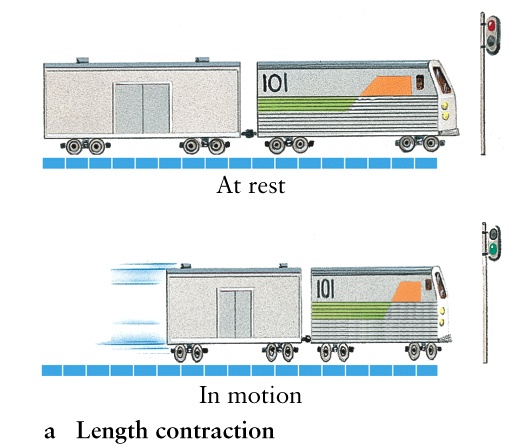
Length Contraction
| A rod is 20 meters long when observed while stationary with respect to an observer. How long is it to an observer
|
L0 = 20 m
L = L0 (1 - v2/c2)1/2 = 3.98 m
|
Time Dilation and Length Contraction
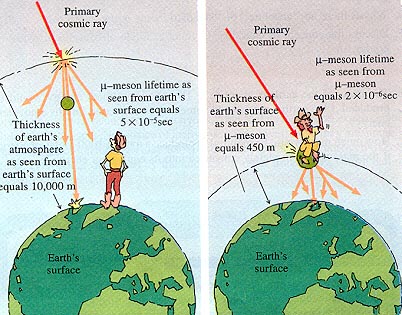 Both observers measure the same relative speed, v. |
Event begins with birth of muon and ends with its disintegration. -------------------------------------------- An observer on earth is moving with respect to the event, so he measures the dilated (longer) time, Dt = 5 x 10-5 s. Same observer measures the |
Energy-Mass Equivalence
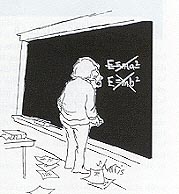 Mass is energy: E = mc2 Energy is mass: m = E /c2 |
When a flashlight radiates a quantity of light energy, it loses mass. --------------------------------------- When a flower absorbs sunlight, its mass increases. --------------------------------------- When a uranium nucleus splits, the mass of the remnants is less than the original mass. The difference appears as light, heat, and kinetic energy. |
Energy to Mass Transformation
 From the sun: 0.10 watts /cm2 |
By how much would the mass of a butterfly increase after one hour facing the sun, assuming all of the energy is absorbed? -------------------------------------- Assume area of butterfly is 75 cm2. Time = 3600 seconds |
DE =
(0.10)(3600)(75)
= 27,000 Joules |
Mass to Energy Transformation
| What is the energy-equivalent of one gram* of matter? E = mc2 = (0.001 kg)(3.0 x 108 m/s)2 = 9 x 1013 J |
One joule is the work done in lifting a one newton weight one meter. 10,000 newtons = 2500 pounds 1,000 meters = 3280 feet (0.6 mile) (10,000 N) (1,000 m) = 107 J ---------------------------------------------------------- About how many one-ton cars could be blasted about 1/2 mile upward if one gram of matter were completely converted to energy? |
Total Energy Rest Energy Kinetic Energy
| What is the total energy of a particle of mass m = 2 kg moving with speed v = 0.9 c? ---------------------------------------- E = mc2 / (1-v2/c2)1/2 = 4.13 x 1017 J |
What is the particles rest energy? ------------------------------------ E0 = mc2 = 1.80 x 1017 J |
What is the particles kinetic energy? -------------------------------------- Kinetic Energy = E - E0 KE = 2.33 x 1017 J |
Hiçbir yazı/ resim izinsiz olarak kullanılamaz!! Telif hakları uyarınca bu bir suçtur..! Tüm hakları Çetin BAL' a aittir. Kaynak gösterilmek şartıyla siteden alıntı yapılabilir.
The Time Machine Project © 2005 Cetin BAL - GSM:+90 05366063183 - Turkiye / Denizli
Ana Sayfa /
index /Roket bilimi /![]() E-Mail /CetinBAL/Quantum Teleportation-2
E-Mail /CetinBAL/Quantum Teleportation-2
Time Travel Technology /Ziyaretçi Defteri /UFO Technology/Duyuru